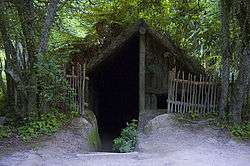The Buried Village

The Buried Village or Te Wairoa is a village located close to the shore of Lake Tarawera in New Zealand's North Island. It was a Māori and European settlement founded in 1848 by the Revd Seymour Mills Spencer where visitors would stay on their way to visit the Pink and White Terraces. The village was destroyed by the eruption of the volcano Mount Tarawera on June 10, 1886. 120 people died in the eruption, many of them in other villages closer to the volcano.[1]
The Buried Village is open to the public and shows the excavated ruins of the village, recovered relics on display in a museum and the history of the eruption. It is located 14 kilometres southeast of Rotorua on Tarawera Road.
A Māori meeting house named Hinemihi which provided shelter to the people of Te Wairoa village during the eruption was relocated in 1892 to Clandon Park as an ornamental garden building and a souvenir of William Onslow, 4th Earl of Onslow.[2]
The Smith Family
Around three to four generations of the Smith Family have had ownership of the land at Te Wairoa. The first generation of the Smith family bought the site of Te Wairoa from the CMS missionary, Rev. Seymour Mills Spencer, at Te Wairoa. From then on the Smith family have run the excavating of Te Wairoa.
Coordinates: 38°12′44″S 176°21′25″E / 38.212346°S 176.357015°E
References
External links
- Buried Village - official site